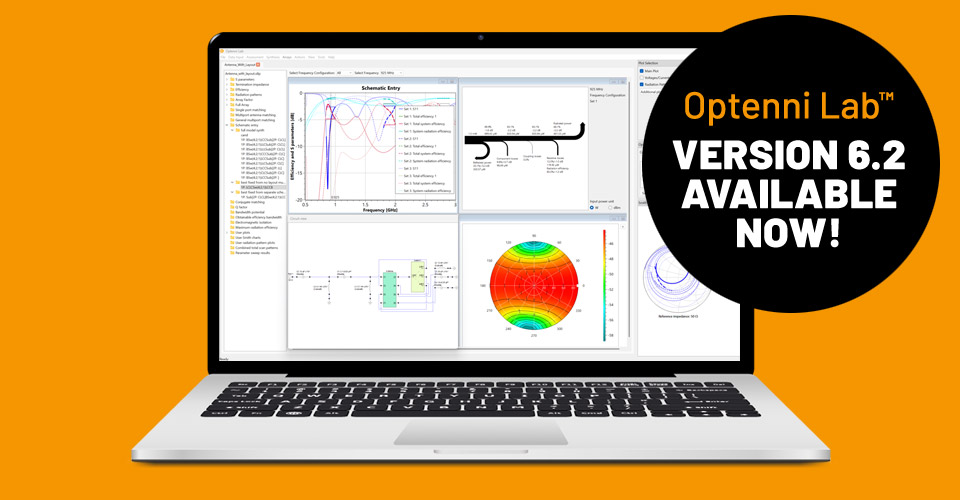
Optenni Lab Used in Sensor Technology
Wireless connectivity is revolutionizing the ways sensors are used in industrial, defense and household use cases. Various aspects of information can be monitored and produced by sensor systems, like video streams, temperature, vibration, moisture, and even the real-time location of sensor devices. Naturally, the ability to perform such monitoring wirelessly requires a battery-powered operation, and radio-based data transfer. This case study shows how Optenni Lab can speed up the design flow of antennas used in sensor systems.
For the radio interface, sensor technologies pose specific requirements that can be summarized as follows:
A
The attachment point of a sensor device can be basically anything – from steel beams to drywalls, and from innards of complex piece of machinery to free space. Thus, location of the device will affect the characteristics of its antenna(s).
B
High efficiency in RF design is required for maximizing wireless connectivity range, and to make the sensor device’s battery last long. Optimized efficiency is critical especially to make energy harvesting a reality.
C
Sensor devices are often mass-produced, and controlling component variations for excellent yield and quality is important.
D
Sensor devices benefit from multi-band and multi-radio wireless connectivity, and making the sensor device antenna(s) cater for many bands is a must.
Practical Example
Let’s study an EM simulated sensor shown in Figure 1, on the left placed on a drywall, and on the right, installed on a steel beam.

Figure 1: Sensor details in a drywall installation & sensor installed to a steel beam
Explore
Following the Optenni Lab paradigm, we first Explore the antenna radiator characteristics (without any matching) with Optenni Lab’s assessment tools. The maximum radiation efficiency curve of Figure 2 can be produced in a matter of seconds.

Figure 2: Maximum radiation efficiency of the two installation cases
It is evident that the drywall installation is a lot more wasteful in terms of energy, as the sensor structure is identical in both cases. At this juncture, the designer must decide if the efficiency in the drywall installation is adequate, or is the redesign of the sensor mechanics and radiator needed. Let’s assume that the design is suitable.
The drywall installation and the steel beam installation yield quite a bit different behavior also for S11.

Figure 3: Installation aspects have a major effect on the antenna impedance of the sensor device
Accelerate
As discussed already in bullet A above, the design problem is now as follows: what is the one matching circuit that best takes into account the two different environments and their effect on the antenna impedance?
In Optenni Lab, this kind of problem is easily handled with Impedance Configurations! With them, everything in Optenni Lab is performed so that both of these antenna characteristics are jointly taken into account in the best possible way (note – any number of impedance configurations is supported).
Let’s take the 2.4 GHz and 5 GHz WIFI bands as frequencies of operation. Within seconds, we get the candidate shown in Figure 4 as the best 0-4 component matching circuit by using Coilcraft 0201DS as inductors and Murata GJM15 as capacitor library elements. And as the results are based on efficiency, longer wireless range and battery life are guaranteed.
This is the accelerate bit of Optenni Lab’s philosophy. Do not waste time in guesswork, let Optenni Lab compute!

Figure 4: Best four component topology proposed
Adding design variations to the circuit is straightforward, as the tolerance analysis is a built-in feature for library components. Sorting circuit topologies by tolerance sensitivity, Optenni Lab points out a much simpler matching circuit with two elements only, shown in Figure 5.

Figure 5: Careful study and tolerance analysis guide the design to a very elegant solution that best caters for the two bands, and for the two installation locations
Maximise
Below, in Figure 6, we have the efficiency of this two-element circuit, in the two studied installation locations (drywall and steel beam).

Figure 6: Total efficiencies with tolerances for the two installation locations
We can also study the power loss mechanisms very easily. Below, based on Optenni Lab Power Balance feature, we have for the steel beam case at 2.42 GHz the results shown in Figure 7.

Figure 7: Steel beam installation power balance at 2.42 GHz
Similarly, for the drywall case at 2.42 GHz, we have the results of Figure 8, again highlighting the resistive losses, caused to power coupled to the drywall.

Figure 8: Drywall installation power balance examples
As Optenni Lab aims for maximal efficiency, it is not possible to improve the matching in one case without worsening the other matching. Managing this design aspect is very difficult with any other tool, but Optenni Lab makes it a breeze. This is the maximise aspect of Optenni Lab’s philosophy.
Conclusion
In this case study we showed how Optenni Lab can speed up the design flow of antennas used in sensor systems. We demonstrated several methods to achieve high RF performance under varying operating conditions, addressing the component variation challenge and other design requirements that are increasingly prevalent in today’s sensor systems.
If wireless sensors are your business, stop wasting time in antenna related guessing.
Instead, book a demo and kick off Optenni Lab evaluation already today:
Optenni Sales team
Email: info (at) optenni.com


